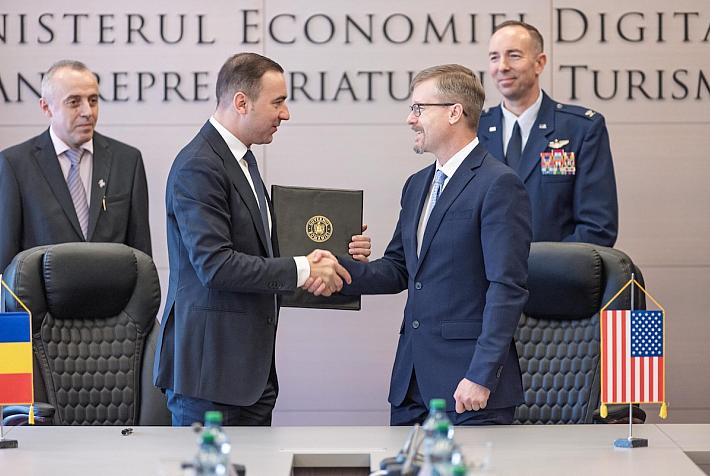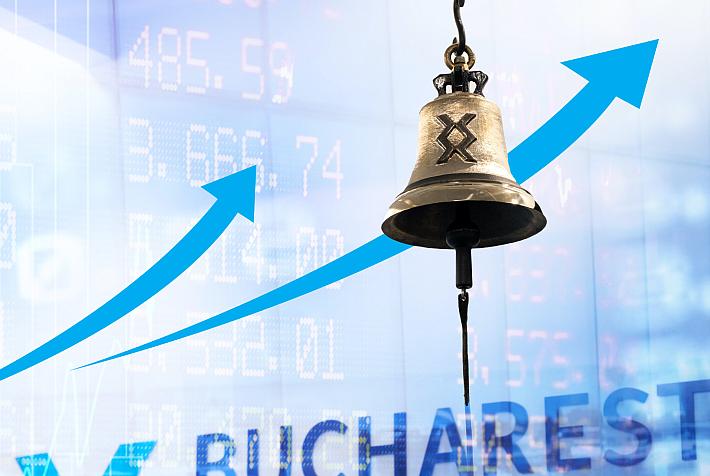A global stage now opening for Romania: diversity focus at Medici.tv

How do you bring more people to the concert hall? Medici.tv had an answer when it did its first broadcast in 2007. Almost ten years on, the platform streaming classical music events carries forward with its mission of showcasing a diverse classical music scene and bringing it within the reach of a wider audience.
This year’s edition of the George Enescu Competition was the first one to be streamed on Medici.tv, the online platform broadcasting classical music events from around the world. The musicians performing in Bucharest were under expanded spotlight as the classical music competition established in 1958 joined the platform’s portfolio of events covering the up-and-coming generation, such as the Tchaikovsky Competition or the Chopin Competition.
Hervé Boissière (pictured), founder and managing director of Medici.tv, says the platform is very keen on presenting music competitions in part from the desire to respect and reflect the diversity of classical music and because such events are an opportunity to present new talent. Boissière, who was in Bucharest at the opening of the Enescu Competition this year, quotes the example of pianists Yuja Wang or Daniil Trifonov, whose performances Medici.tv first recorded at the 2007 Verbier Festival, where it did its initial broadcast. “We are very proud when we can say we were there the first time an artist won the prize or gave a first concert at a festival,” he says.
The streaming of the Enescu Competition fits along the same line. “We started to discuss about the festival two years ago and when I saw the lineup and the programing I said “My God, there is fantastic stuff here.” And we love to be not only in New York, Tokyo, London, so we said why not start a more diversified presence,” Boissière explains.
He mentions Sebastian Androne’s Tektonum, the winning piece of the Enescu Competition composition section in 2014, to support the case for showing a diverse range of performances and repertoire. The piece was performed for the first time at the opening concert of this year’s event. “It is great to show, to imagine that our community, 99 percent of our audience never heard it,” he says, arguing in favor of exploring novel content. “Of course it is important to reflect and to combine the biggest names but never forget new talent, new repertoire, competitions, chamber music, especially because those programs are never filmed for television now.” And where popularity or ratings take precedence, he says Medici is interested in showing content that is little-known. “We love to go to not so popular repertoire or artists.”
Sharing the stage
Before starting Medici.tv, Hervé Boissière worked in the record industry as managing director of French indie label Naïve, and on various executive positions at Warner Music France and Warner Classics. In 2007 he was working on the beta version of Medici.tv, which did its first broadcast the same year.
Boissière remembers the moment of the launch as one of trial for the industry. “Either you were suffering and complaining, seeing your sales go down and losing your responsibility of helping the artist or you were looking for a new way to do your job and continue your mission, which is to support the artist and to reach the public,” he explains.
With YouTube launched in 2005 and video streaming starting on the internet, the context was shaping up for a venture that was looking to combine audio and visual, “to be live, which was a key difference from the usual recording business and to really share the stage with the public, to really make [that] possible for all the people who cannot attend [the concert].”
The service is sometimes described as the Netflix of classical music. But while it shares with the US entertainment company the streaming model, Medici viewers can watch events for free when live and for a defined period after. Subscription-based, on-demand access is available onwards, providing access to a library of more than 1,600 concerts, films, archive material and documentaries.
Boissière was estimating that the new format would mean expanding the concert hall from 1,000 – 2,000 people in the venue to 30 – 40,000 but for the first broadcast viewers tuned in at numbers exceeding expectations. “We didn’t know how it was working, if it will be a success or a big failure. Technically speaking it was so new and, everything went very well, the artists really loved it and the public was there. We had around 700,000 connections from the very first festival, which was a big surprise.”
Based on this first experience, the venture continued with a platform that fits the model of content distributed on connected devices. “There is a complete new, on-demand way of enjoying performing arts,” he explains, highlighting how important it was to anticipate the rise of connected streams but also the less precise factors that went into the decision of establishing the platform. “When we started it was a lot of intuition, a lot of passion about music, about artists but the business model was not really clear, to be honest. If we had been clear about the business model we would have never opened Medici,” he says laughing. “So it was actually great to be so naïve and just like ‘let’s do it and we’ll see what happens.’ When you are disruptive you must go to the point and after you see how it works."
If you do your market research everybody will tell you: don’t do it.
A diversified model
Medici rests on a revenue stream which includes subscriptions to the content library, sponsorships, distribution to the educational market and licensing to third-party platforms.
The platform has more than 12,000 subscribers on a yearly basis. As it has viewers in 180 countries for the large events it broadcasts, the platform also attracts sponsorship from luxury companies or banking services. At the same time, the content on Medici.tv is distributed as an educational resource for music schools, conservatories and libraries of universities, which in turn make the content available to their students and professors for free. The platform counts almost 200 clients for its educational segment, mainly from the US. In addition, Medici sometimes licenses content it produces or co-produces to third-party platforms such as Amazon, Apple TV or Canal+. Programs that get distributed this way include 50 Best Operas or the Best Concertos.
High-tech expectations
With technology core to the platform’s development, Medici is a member of Cap Digital, the French business cluster for digital content and services, from where it can source the R&D and innovation knowledge fitting its profile. “We are not completely a high-tech company. We are a content company, we are a music company, we are passionate about artists and for doing our work we need technology,” Boissière explains.
Medici has redesigned its platform this year, having the user experience in view but also the need to integrate what it has learned in recent years regarding user habits and social media. “People don’t accept average quality now. That time is over. Maybe ten years ago when we started, the streaming was sometimes so and so, but people were already happy because they were like ‘cool, I can enjoy the Salzburg festival, ok sometimes it stops but it’s so cool to watch this opera.’ Now they want to watch the Salzburg without any problem. If there is a problem, you’re dead.”
The data gathered also goes into adjusting the marketing for various regions where the platform broadcasts, taking into account tailored approaches to suit specific markets.
Star content
Opera performances are some of the most watched content on Medici. “The opera is always a very big hit because, first of all, it is visual art. People love to see the staging, the sets and the costumes, everything. So of course, when we have the privilege to be in Salzburg, for instance, it’s a very big success. We had around 500,000 views for the latest operas we did in Salzburg,” he explains.
With the US being Medici’s first market, Carnegie Hall broadcasts are also at the top of viewers’ preferences. The appeal draws on a combination of a large audience - around 30 percent of the platform’s total comes from the US - and big names ranging from Daniil Trifonov and Gustavo Dudamel to Evgeny Kissin and Joyce DiDonato. The partnership took three years to negotiate and Boissière calls it a “special achievement.” “The unions in New York are the strongest in the industry because it’s a long tradition of Broadway and in the concert venues or theaters they have very strong rules for managing the media coverage of their shows. Carnegie Hall being in New York has the same rules, so it was important to find a way to explain we were not the same as the commercial television.”
Historically, since the start of the platform, the Tchaikovsky Competition brought in the highest numbers: 12 million views. “This reflects quite well our diversity because it’s really completely different countries, repertoire or type of programs,” he says.
The platform partners either with orchestras or concert venues but generally the artistic content is the outset in developing a relationship where he says the trust of the artist is key. “That’s the starting point and what we really want to protect, value and increase. The relationship with the artistic community is the key. If you don’t have their confidence, if you don’t have the wish to build something together, I don’t say it’s not possible to do a good job but you lose so much. That’s our DNA, to establish a relationship,” he explains, giving one example of how this relationship is nurtured. “When an artist is not happy about a live streaming, about their performance [in a streaming] we always remove the recording. Always. […] With this type of confidence people are comfortable with us and are giving more. If you give a lot, you receive a lot,” he sums up.
Looking forward
Against the background of the shift brought by the playlist model, he argues it is the job of the industry to find new ways of reaching and engaging the public. “We have to be proactive, we have to take the initiative, it won’t come spontaneously, there is a lot of responsibility on our shoulders.”
To worries about a diminishing and ageing audience for classical music he answers with a global perspective. “It is absolutely true that in Old Europe – Paris, London, Munich – even a bit in the States, but even in the States it’s different - people are getting older. But go to Asia, go to Seoul, go to Taiwan, go to Beijing, to Shanghai, people are twenty – thirty years old. Go to Brazil, go to Venezuela, go to Argentina. We are in a global world. […] My interest is to see how I can combine the new generation fascinated by Western classical music in China,” he explains.
He also looks at the interaction model proposed by museums as something the classical music industry could possibly replicate. “They created completely lively places with the bookstores, they changed completely the presentation, they became pedagogic, explaining the painting, with audio etc. So now it’s an experience for everybody. I think classical music can be in the same mode.” He gives the example of events that are making music “more open, more friendly, more accessible”, like The Proms in London, and he counts Medici’s proposal to find new channels to reach the audience as one of the answers. “I just stay very humble about that but it’s in our mission to be part of that democratization of classical music,” while remaining confident because “the quality of classical music is so strong and so deep. There is no risk.”
A tradition of classical music he says he recognized while he was in Bucharest. “There is such a deep and long tradition of classical music in the country and Enescu is, of course, an iconic artist for the people. I walked a little bit and there was a very old man selling books in the streets, it was around 11 pm, and he had very many Romanian books; he had two or three books on Enescu and I bought them in Romanian. I can’t read them but I just wanted to keep that as a souvenir because I feel there is so much pride for the country.”
By Simona Fodor, Associate Editor, City Compass Media, simona@citycompass.ro











